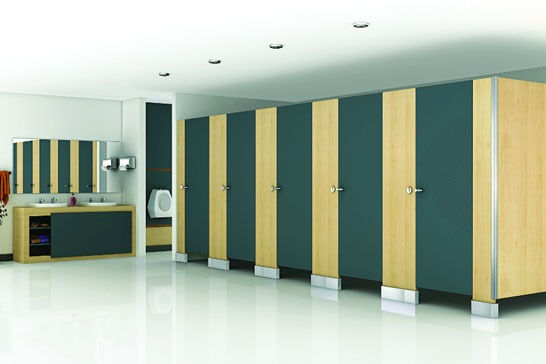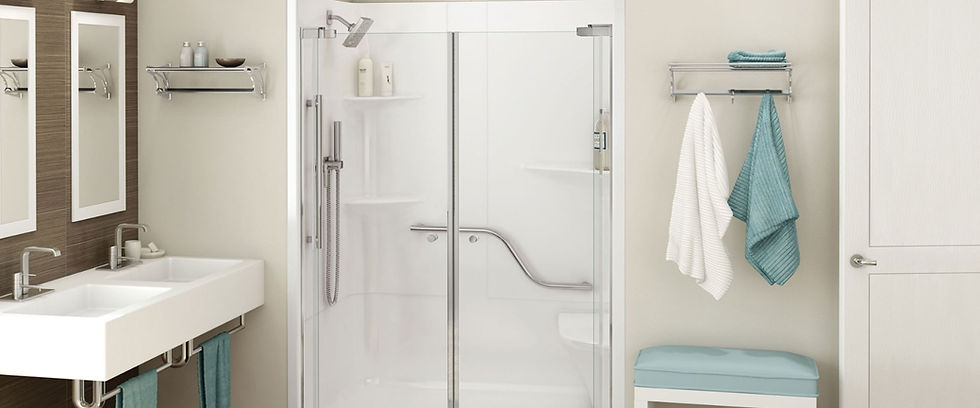Toilet Cubicles: A Comprehensive Guide to Design, Materials,
- Tanu Adhikari

- Oct 18, 2024
- 5 min read
Updated: Jul 9
Restrooms play a vital role in any commercial or public facility, and the choice of toilet cubicles significantly impacts both functionality and user satisfaction. Whether for an office building, shopping mall, or public park, Toilet Cubicle Manufacturers must be designed with care, made from high-quality materials, and installed to meet safety and hygiene standards. This in-depth guide explores the various types of cubicles, the best materials for specific environments, advanced features, installation steps, and maintenance strategies.
Understanding the Different Types of Toilet Cubicles
Toilet cubicles vary depending on their application, environment, and user needs. Each type serves a specific purpose and offers different advantages.
Standard Toilet Cubicles
Standard cubicles are the most common, found in schools, offices, and commercial establishments. They provide basic privacy and are made from durable materials such as high-pressure laminate or compact laminate. These cubicles are budget-friendly and easy to install, making them suitable for environments where the demand for high-end finishes is minimal.
Full-Height Toilet Cubicles
Full-height cubicles extend from floor to ceiling, creating a completely enclosed space. These are ideal for environments that demand greater privacy, such as high-end hotels or corporate offices. Full-height cubicles reduce noise and prevent odors from spreading, contributing to a cleaner, more private restroom environment. The materials used are typically more premium, such as phenolic resin or solid-grade laminate.
Junior Cubicles for Children
Designed specifically for schools and child-friendly environments, junior cubicles are lower in height and feature easy-to-use locks. These cubicles are brightly colored and made from child-safe, durable materials. In daycares, nurseries, and primary schools, junior cubicles help ensure the comfort and safety of young users.
Accessible Toilet Cubicles
Accessible or disabled-friendly cubicles are designed in compliance with accessibility standards, ensuring that individuals with disabilities can use the restroom with ease. These cubicles are spacious, fitted with grab bars, and feature outward-opening doors for easy entry and exit. They often come equipped with emergency assistance alarms and additional space for caregivers.
Anti-Vandal Toilet Cubicles
For environments prone to vandalism, such as public restrooms in stadiums, parks, and train stations, anti-vandal cubicles are the perfect solution. Constructed from extremely durable materials like stainless steel or solid-grade laminate, these cubicles are resistant to scratching, graffiti, and impact. Anti-vandal cubicles provide a long-lasting solution for high-traffic areas where maintenance is a concern.
Shower and Wet Room Cubicles
In places like gyms, spas, and swimming pools, shower cubicles or wet room cubicles are essential. These cubicles are constructed with materials that resist water, moisture, and mildew. Compact laminate and phenolic core materials are widely used due to their water resistance. These cubicles also often feature integrated drainage systems to prevent water accumulation and slippage.
Key Features to Consider in Modern Toilet Cubicles
While the basic purpose of a toilet cubicle is to provide privacy, modern designs go beyond that. They offer a variety of features that enhance comfort, durability, and aesthetics.
Durability and Strength
One of the most important aspects of any cubicle is its durability. High-traffic environments, such as airports and shopping malls, require materials that can withstand constant use and potential damage. Solid-grade laminate (SGL) and compact laminate are often preferred for these settings due to their strength, water resistance, and ability to resist vandalism.
Fire Resistance
In certain environments, particularly in public buildings, choosing cubicles with fire-resistant properties is a must. Compact laminates and solid phenolic materials meet fire safety standards and help ensure that restrooms are safer space during emergencies. Installing fire-rated toilet cubicles can be a legal requirement in some commercial spaces.
Water and Humidity Resistance
Restrooms in humid environments like swimming pools, spas, and gyms require cubicles that can withstand constant exposure to moisture. Compact laminate and phenolic resin cubicles are ideal for these settings as they resist swelling, delamination, and warping, even in high-humidity areas. Ensuring the materials are water-resistant will prevent mould growth and prolong the lifespan of the cubicles.
Privacy and Noise Control
While privacy is the primary function of any cubicle, certain settings may demand even more. Full-height cubicles offer complete privacy, reducing noise transfer and ensuring a quiet, peaceful experience. These are ideal for high-end offices, luxury hotels, and other premium facilities where user comfort is a top priority.
Aesthetics and Customization
Many businesses want their restroom facilities to reflect their overall branding or ambience. Cubicles can now be customized with a wide range of colours, patterns, and finishes to create the desired look. From sleek metallic finishes in modern office buildings to playful bright colours in children’s areas, the design possibilities are nearly endless.
The Importance of Professional Installation
The installation of toilet cubicles is a precise process that requires professional attention. Proper installation ensures that cubicles are secure, durable, and compliant with local regulations. Let’s explore the steps involved:
Measuring and Planning
Before any installation can begin, precise measurements must be taken. Restroom dimensions, including doorways, walls, and plumbing locations, are factored into the design. During this stage, the installation team also ensures that the layout complies with building codes and accessibility regulations.
Setting the Framework
The first step in the installation is to assemble the framework for the cubicles. This typically involves setting up aluminium profiles, support legs, and headrails to ensure the structure is solid and level. The framework serves as the foundation for the rest of the cubicle installation.
Attaching the Panels and Doors
Once the framework is in place, the cubicle panels and doors are installed. The panels are mounted using durable fixings that ensure stability and strength, even in high-traffic environments. Doors are aligned to open and close smoothly, and any gaps between panels are minimized for maximum privacy.
Fitting Locks and Accessories
After the panels and doors are in place, accessories such as locks, hinges, and handles are attached. Modern toilet cubicles often feature soft-close doors and indicator locks to enhance the user experience. Inaccessible cubicles, grab rails, and emergency pull cords are installed for safety.
Final Adjustments and Inspection
The installation team will perform a thorough inspection to ensure everything is properly aligned and functioning. Any necessary adjustments are made, and the cubicles are tested for stability, door operation, and lock functionality.
Maintenance Strategies for Toilet Cubicles
Maintaining toilet cubicles is essential for prolonging their lifespan and ensuring they remain hygienic and functional. Regular cleaning, inspections, and repairs are crucial.
Daily Cleaning
Restrooms in commercial or public buildings should be cleaned regularly to prevent the buildup of dirt and bacteria. Use non-abrasive cleaning products and soft cloths to wipe down laminate surfaces. For stainless steel cubicles, a stainless steel cleaner can be used to maintain the surface’s shine.
Routine Inspections
Regular inspections of the cubicles can help identify wear and tear early. Check hinges, locks, and panels for any signs of loosening, rust, or damage. Addressing small issues before they become bigger problems can save on costly repairs or replacements.
Addressing Water Damage
For restrooms that experience high moisture levels, it’s essential to monitor cubicles for any signs of water damage. Materials like compact laminate are resistant to water, but regular inspections ensure that the edges and joints are not exposed to prolonged moisture. Installing proper ventilation systems can also reduce humidity buildup.
Vandalism and Graffiti Removal
In high-traffic or public restrooms, vandalism can be a concern. Anti-vandal cubicles are designed to withstand harsh treatment, but graffiti or minor damage should be dealt with promptly. Use appropriate cleaners to remove graffiti without damaging the cubicle material. For scratched or damaged panels, professional repair services may be required.
Conclusion: Elevating Restrooms with High-Quality Toilet Cubicles
Toilet cubicles are an integral part of any commercial restroom. From the materials chosen to the design and installation process, every aspect contributes to the overall functionality and appearance of the space. By selecting the right type of Toilet Cubicle Manufacturer, ensuring professional installation, and committing to regular maintenance, businesses can create a restroom experience that is clean, safe, and enjoyable for users.







Comments